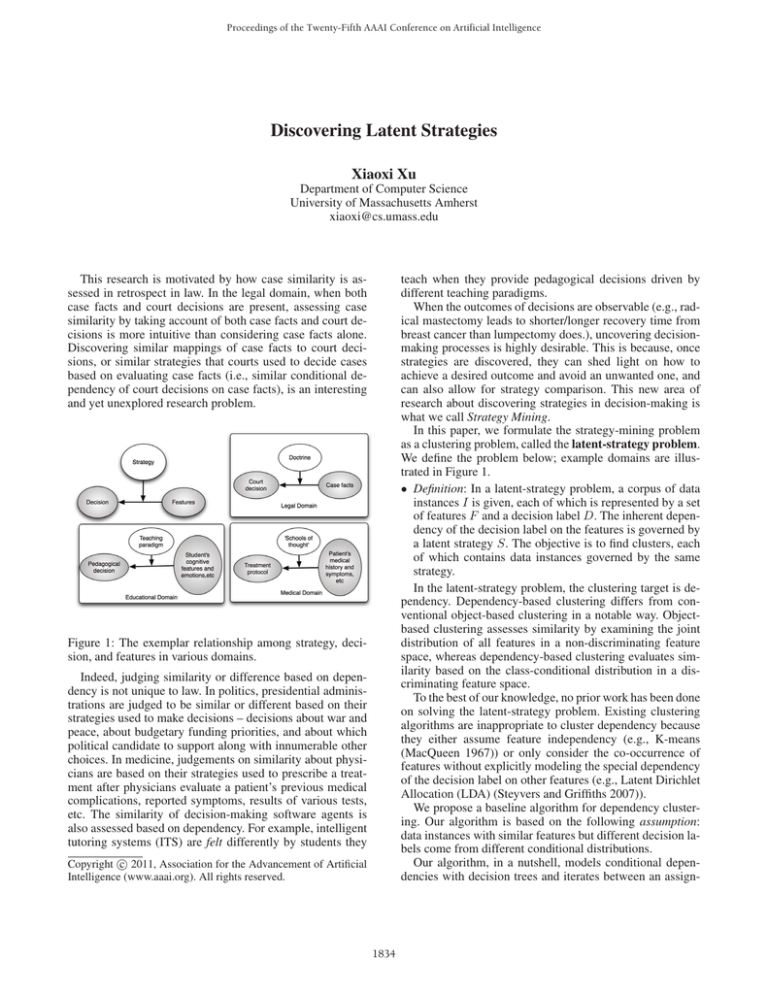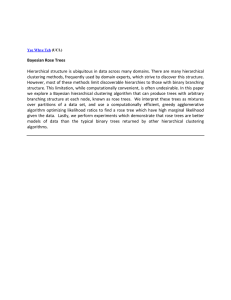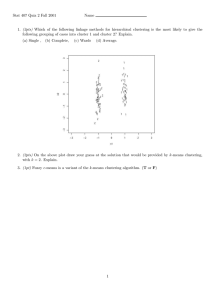
Proceedings of the Twenty-Fifth AAAI Conference on Artificial Intelligence
Discovering Latent Strategies
Xiaoxi Xu
Department of Computer Science
University of Massachusetts Amherst
xiaoxi@cs.umass.edu
teach when they provide pedagogical decisions driven by
different teaching paradigms.
When the outcomes of decisions are observable (e.g., radical mastectomy leads to shorter/longer recovery time from
breast cancer than lumpectomy does.), uncovering decisionmaking processes is highly desirable. This is because, once
strategies are discovered, they can shed light on how to
achieve a desired outcome and avoid an unwanted one, and
can also allow for strategy comparison. This new area of
research about discovering strategies in decision-making is
what we call Strategy Mining.
In this paper, we formulate the strategy-mining problem
as a clustering problem, called the latent-strategy problem.
We define the problem below; example domains are illustrated in Figure 1.
• Definition: In a latent-strategy problem, a corpus of data
instances I is given, each of which is represented by a set
of features F and a decision label D. The inherent dependency of the decision label on the features is governed by
a latent strategy S. The objective is to find clusters, each
of which contains data instances governed by the same
strategy.
In the latent-strategy problem, the clustering target is dependency. Dependency-based clustering differs from conventional object-based clustering in a notable way. Objectbased clustering assesses similarity by examining the joint
distribution of all features in a non-discriminating feature
space, whereas dependency-based clustering evaluates similarity based on the class-conditional distribution in a discriminating feature space.
To the best of our knowledge, no prior work has been done
on solving the latent-strategy problem. Existing clustering
algorithms are inappropriate to cluster dependency because
they either assume feature independency (e.g., K-means
(MacQueen 1967)) or only consider the co-occurrence of
features without explicitly modeling the special dependency
of the decision label on other features (e.g., Latent Dirichlet
Allocation (LDA) (Steyvers and Griffiths 2007)).
We propose a baseline algorithm for dependency clustering. Our algorithm is based on the following assumption:
data instances with similar features but different decision labels come from different conditional distributions.
Our algorithm, in a nutshell, models conditional dependencies with decision trees and iterates between an assign-
This research is motivated by how case similarity is assessed in retrospect in law. In the legal domain, when both
case facts and court decisions are present, assessing case
similarity by taking account of both case facts and court decisions is more intuitive than considering case facts alone.
Discovering similar mappings of case facts to court decisions, or similar strategies that courts used to decide cases
based on evaluating case facts (i.e., similar conditional dependency of court decisions on case facts), is an interesting
and yet unexplored research problem.
Figure 1: The exemplar relationship among strategy, decision, and features in various domains.
Indeed, judging similarity or difference based on dependency is not unique to law. In politics, presidential administrations are judged to be similar or different based on their
strategies used to make decisions – decisions about war and
peace, about budgetary funding priorities, and about which
political candidate to support along with innumerable other
choices. In medicine, judgements on similarity about physicians are based on their strategies used to prescribe a treatment after physicians evaluate a patient’s previous medical
complications, reported symptoms, results of various tests,
etc. The similarity of decision-making software agents is
also assessed based on dependency. For example, intelligent
tutoring systems (ITS) are felt differently by students they
c 2011, Association for the Advancement of Artificial
Copyright Intelligence (www.aaai.org). All rights reserved.
1834
(a) AM-DTM
(b) K-means
(c) LDA
Figure 2: Ten-fold cross-validation & training errors of decision trees built using 1 of the 3 data clusters given by (a) AM-DTM,
(b) K-means, and (c) LDA. The selected clusters are representative to the general truth of all clusters.
ment step and a minimization step to learn a mixture of decision tree models that represent latent strategies. We call this
algorithm Assignment Minimization for Decision Tree Mixtures (AM-DTM). AM-DTM starts from partitioning data
into K disjoint datasets, which are used to build K initial
decision trees. Techniques should be used to avoid overfitting. The main body of AM-DTM consists of two iterative
steps: an assignment step (A-step) and a minimization step
(M-step). In the A-step, instances are assigned to clusters
based on decision trees’ classification results. The assignment strategy is as follows. If an instance in a cluster is correctly classified by the decision tree built from that cluster,
it will stay in the original cluster; otherwise, it will move
to a cluster whose decision tree correctly classifies it. When
there are more than one decision tree that correctly classifies a misclassified instance, that instance will move to the
cluster whose decision tree yields the highest classification
probability for it. Further ties are broken by preferring the
decision tree whose leaf node has a greater number of instances underneath. If there is no decision tree that correctly
classifies an instance, that instance will stay in its original
cluster. In the M-step, decision tree learning is performed
and the total training error of all decision trees is minimized
under the assumption that the assignment from the A step is
correct. To ensure and speedup convergence, we replace an
older decision tree with a new one for a cluster only when
the new tree has a lower training error. This process is repeated until no instance is moved. The goal of the iteration
is to minimize the overall training error so that the learned
decision trees representing coherent concepts can be found
accurately. Similar to the Expectation Maximization algorithm (Little and Rubin 2002), AM-DTM follows the empirical risk minimization principle from PAC learning theory.
We carried out a set of experiments to evaluate AM-DTM
in a legal domain. Our dataset (Rissland and Xu 2011) contains 151 actual cases taken from a variety of jurisdictions in
the United States and in the United Kingdom. Although the
legal doctrine used for deciding each case was not recorded
at dataset construction, domain knowledge tells us that each
case in the dataset was decided by one of three known doctrines. Initial results showed that (1) AM-DTM converged
within a few iterations (5 iterations on average of 10 runs),
(2) its learned decision trees are compact (5 leaf nodes, on
average, which conforms to the fact that legal doctrines are
usually not complex rules), with low training errors (0.03 on
average) and low cross-validation errors (0.06 on average),
(3) the learned decision trees in overall resemble the doctrines well, and (4) AM-DTM significantly outperformed
K-means and LDA on clustering dependency as shown in
Figure 2 (e.g., decision trees learned from clusters given by
K-means and LDA have high cross-validation errors).
AM-DTM has three notable characteristics. First, it is
irrelevant-feature resistant, because the decision tree model
used by AM-DTM can automatically select key features
that significantly influence the decision. Second, it is a
glass-box learning algorithm, because one can easily evaluate and explain clustering results by examining the look
of the learned decision trees. Finally, the outputs of AMDTM are predictive, because the learned decision trees allow for similarity-based retrieval and classification tasks on
new data. In future work, we will develop algorithms that use
other non-parametric statistical models, parametric discriminative models, and parametric generative models to cluster
conditional dependency, and compare them with AM-DTM.
Acknowledgments
The author is especially grateful to David Jensen for his
guidance. The author also thanks Edwina Rissland for her
feedback and the reviewers for their constructive comments.
References
Little, R. J. A., and Rubin, D. B. 2002. Statistical Analysis
with Missing Data, Second Edition. Wiley-Interscience.
MacQueen, J. 1967. Some methods for classification and
analysis of multivariate observations. Proc. of the Fifth
Berkeley Symposium on Mathematics, Statistics and Probability 1(5):281–296.
Rissland, E. L., and Xu, X. 2011. Catching gray cygnets:
An initial exploration. In Proceedings of the Thirteenth International Conference on Artificial Intelligence and Law
(ICAIL). To appear.
Steyvers, M., and Griffiths, T. 2007. Probabilistic topic models. Handbook of Latent Semantic Analysis 22:424–440.
1835







